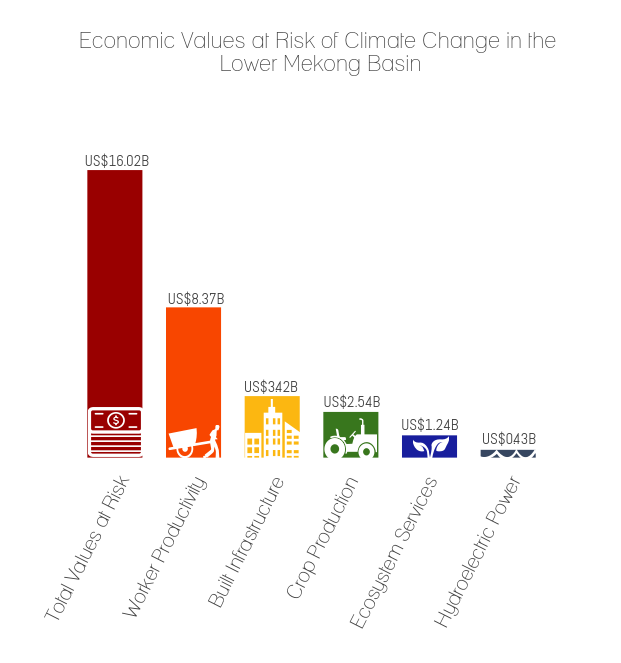Home » News & Information » Press Releases » Lower Mekong Economies Risk Losing $34 Billion Per Year from Climate Change: USAID Report

Economic values at risk of climate change in the Lower Mekong basin
Mekong Adaptation and Resilience to Climate Change project
For Immediate Release
Monday, February 23, 2015
BANGKOK, February 23, 2015 -- Future economic impacts of climate change in the Lower Mekong Basin are likely to be wide-ranging and could top $30 billion annually, according to a new report by the U.S. Agency for International Development (USAID). Of most concern are potentially significant reductions in the yield of crops, fish and non-timber forest products critical for livelihoods, damage to infrastructure associated with floods and sea level rise, and an increase in the incidence and severity of heat-related illnesses for workers.
The report, titled Climate Change in the Lower Mekong Basin: An Analysis of Economic Values at Risk, estimates that, based on current values, impacts from climate change could cost Cambodia, Lao PDR, Thailand and Vietnam at least $16 billion per year in damage to natural resource assets and infrastructure services, and an additional $18 billion annually in potential infrastructure damage or loss from flooding and other extreme weather events. This amount demonstrates the profound risk that climate change represents and points to a need to align national adaptation strategies to reduce this risk where possible.
Part of the USAID Mekong Adaptation and Resilience to Climate Change (USAID Mekong ARCC) project, the report draws from a 2013 USAID analysis of climate change impacts in the Lower Mekong Basin that forecasts more extreme temperatures, rainfall, weather events and sea level rise for the region by 2050.
“We hope this work will help equip policymakers with the kind of information and analysis that can better prioritize investments in climate change adaptation and spur follow-on valuation studies in the region,” said USAID Regional Development Mission for Asia Director Michael Yates.
The report’s Economic Values at Risk analysis finds that the single highest value asset at risk from climate change in the region is worker productivity: more than $8 billion at risk per year in lost work days due to heat-induced illness. High temperatures, already affecting open-air workers such as farmers and construction workers, will likely increase as a result of climate change, causing spikes in cases of heat stress and other heat-related illnesses in the dry seasons. “So much of the Lower Mekong Basin’s economy is based on outdoor labor,” says report author John Talberth, Senior Economist, World Resources Institute.“Worker productivity should be front and center for any adaptation plans, and fast-tracked.”
Built infrastructure services ($3.4 billion), crop production ($2.54 billion), ecosystem services ($1.24 billion) and hydroelectric power ($430 million) are also at risk from climate change. Despite the challenge posed by climate change, Talberth is certain that positive steps can be taken to address potential economic and environmental losses, advising that “if we address the problem early enough—and it is still early enough—we can make investments that are likely to pay off many times over.”
To download the complete Values at Risk report, visit: http://mekongarcc.net/sites/default/files/usaid_marcc_values_at_risk_rep... (link is external)
For the Overview of Values at Risk report, visit: http://mekongarcc.net/resource/report-climate-change-lower-mekong-basin-... (link is external)
For more information about the Values at Risk report and an exclusive interview with the report’s author, John Talberth, visit: http://mekongarcc.net/blog/interview-john-talberth-wri-senior-economist-... (link is external)







Comment
Make a general inquiry or suggest an improvement.